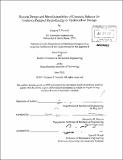| dc.contributor.advisor | Alexander H. Slocum. | en_US |
| dc.contributor.author | Fennell, Gregory E. (Gregory Edmund) | en_US |
| dc.contributor.other | Massachusetts Institute of Technology. Dept. of Mechanical Engineering. | en_US |
| dc.date.accessioned | 2011-12-19T18:50:25Z | |
| dc.date.available | 2011-12-19T18:50:25Z | |
| dc.date.copyright | 2011 | en_US |
| dc.date.issued | 2011 | en_US |
| dc.identifier.uri | http://hdl.handle.net/1721.1/67779 | |
| dc.description | Thesis (Nav. E. and S.M.)--Massachusetts Institute of Technology, Dept. of Mechanical Engineering, 2011. | en_US |
| dc.description | Cataloged from PDF version of thesis. | en_US |
| dc.description | Includes bibliographical references (p. 210-217). | en_US |
| dc.description.abstract | Offshore wind and energy storage have both gained considerable attention in recent years as more wind turbine capacity is installed, less attractive/economical space remains for onshore wind, and load-leveling issues make integrating wind power into the existing electrical grid difficult. For depths greater than 50m, floating wind turbines are expected to be more economical than pylon-based wind turbines, In order for offshore wind energy to maintain a steady supply to the grid without excessive ramping-up and ramping-down of onshore, fossil-fueled power generation units and to reduce the cost of wind integration, some form of energy storage is required. The greater water depths in which floating wind turbines are located can provide an opportunity for a unique energy storage concept that takes advantage of the hydrostatic pressure at ocean depths to create a robust pumped energy storage device. Coupling this energy storage system with a floating wind farm provides a more consistent and predictable power plant that could ultimately lessen the cost of large-scale wind integration, consistently reduce fossil fuel use, and reduce greenhouse gas (GHG) emissions and load-level onshore generation. Additionally, the same type of device structure can be used for undersea hydrocarbon storage during periods of hurricane/tropical storm shut-in's at oil wellheads, maintaining wellhead production without risking personnel or environmental safety due to storm evacuations at the rigs on the surface. | en_US |
| dc.description.statementofresponsibility | by Gregory E. Fennell. | en_US |
| dc.format.extent | 282 p. | en_US |
| dc.language.iso | eng | en_US |
| dc.publisher | Massachusetts Institute of Technology | en_US |
| dc.rights | M.I.T. theses are protected by
copyright. They may be viewed from this source for any purpose, but
reproduction or distribution in any format is prohibited without written
permission. See provided URL for inquiries about permission. | en_US |
| dc.rights.uri | http://dspace.mit.edu/handle/1721.1/7582 | en_US |
| dc.subject | Mechanical Engineering. | en_US |
| dc.title | System design and manufacturability of concrete spheres for undersea pumped hydro energy or hydrocarbon storage | en_US |
| dc.type | Thesis | en_US |
| dc.description.degree | Nav.E.and S.M. | en_US |
| dc.contributor.department | Massachusetts Institute of Technology. Department of Mechanical Engineering | |
| dc.identifier.oclc | 767585866 | en_US |
